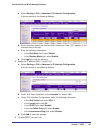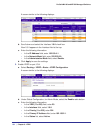
Chapter 9. VRRP | 129
9
9. VRRP
Virtual Router Redundancy Protocol
This chapter provides the following examples:
• VRRP on a Master Router on page 130
• VRRP on a Backup Router on page 132
When an end station is statically configured with the address of the router that will handle its
routed traf
fic, a single point of failure is introduced into the network. If the router goes down,
the end station is unable to communicate. Since static configuration is a convenient way to
assign router addresses, Virtual Router Redundancy Protocol (VRRP) was developed to
provide a backup mechanism.
Layer 3 switch
acting as router 1
Layer 3 switch
acting as router 2
Port 1/0/2
192.150.2.1
Virtual router ID 20
Virtual addr. 192.150.2.1
Port 1/0/4 VLAN
192.150.4.1
Virtual router ID 20
Virtual addr. 192.150.2.1
Layer 2 Switch
Hosts
Figure 15. VRRP
VRRP eliminates the single point of failure associated with static default routes by enabling a
backup router to take over from a master router without affecting the end stations using the
route. The end stations use a virtual IP address that is recognized by the backup router if the
master router fails. Participating routers use an election protocol to determine which router is
the master router at any given time. A given port could appear as more than one virtual
router to the network. Also, more than one port on a M4100 and M7100 Managed Switch can
be configured as a virtual router. Either a physical port or a routed VLAN can participate.


















